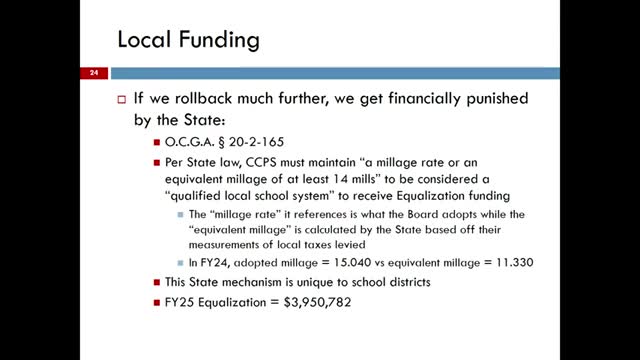School district faces budget crisis amid rising costs
August 06, 2024 | Catoosa County, School Districts, Georgia

This article was created by AI summarizing key points discussed. AI makes mistakes, so for full details and context, please refer to the video of the full meeting. Please report any errors so we can fix them. Report an error »

In a recent government meeting, officials discussed the financial challenges facing local school districts, highlighting a potential loss of $4 million in equalization funding if certain mill rates drop below 14. The meeting revealed that the district's adjusted net tax digest has fluctuated, with revenues increasing from approximately $35 million last year to an estimated $47 million this year, largely due to changes in the tax digest.
Key financial pressures were outlined, including state-mandated healthcare increases that have surged local costs to about $10.5 million annually. The district is grappling with rising expenses for essential personnel, such as maintenance and transportation staff, which are not fully funded by state allocations. Despite receiving some additional funding for transportation, it only covers about 37% of the expected costs.
The board has been operating with a deficit budget for years, intentionally depleting reserves to minimize taxpayer impact. However, with reserves now at critical levels, officials expressed concern over the sustainability of this approach. The district has lost approximately $10.5 million in state funding over recent years due to changes in local fair share and equalization calculations.
Projected expenses for the upcoming fiscal year are expected to reach $137.6 million, driven by state-mandated salary increases and healthcare costs. The district anticipates a deficit of about $678,000, which would reduce the fund balance to approximately $4.6 million by the end of the fiscal year.
Cost-cutting measures have included eliminating around 40 instructional positions and 25 paraprofessional roles, which could lead to increased class sizes. The district is also exploring ways to reduce insurance premiums and has identified $65,000 in savings through adjustments to employee health benefits.
Overall, the meeting underscored the pressing financial challenges faced by the district, as officials seek to balance budgetary constraints with the need to maintain educational services amid rising costs and stagnant state funding.
Key financial pressures were outlined, including state-mandated healthcare increases that have surged local costs to about $10.5 million annually. The district is grappling with rising expenses for essential personnel, such as maintenance and transportation staff, which are not fully funded by state allocations. Despite receiving some additional funding for transportation, it only covers about 37% of the expected costs.
The board has been operating with a deficit budget for years, intentionally depleting reserves to minimize taxpayer impact. However, with reserves now at critical levels, officials expressed concern over the sustainability of this approach. The district has lost approximately $10.5 million in state funding over recent years due to changes in local fair share and equalization calculations.
Projected expenses for the upcoming fiscal year are expected to reach $137.6 million, driven by state-mandated salary increases and healthcare costs. The district anticipates a deficit of about $678,000, which would reduce the fund balance to approximately $4.6 million by the end of the fiscal year.
Cost-cutting measures have included eliminating around 40 instructional positions and 25 paraprofessional roles, which could lead to increased class sizes. The district is also exploring ways to reduce insurance premiums and has identified $65,000 in savings through adjustments to employee health benefits.
Overall, the meeting underscored the pressing financial challenges faced by the district, as officials seek to balance budgetary constraints with the need to maintain educational services amid rising costs and stagnant state funding.
View full meeting
This article is based on a recent meeting—watch the full video and explore the complete transcript for deeper insights into the discussion.
View full meeting
